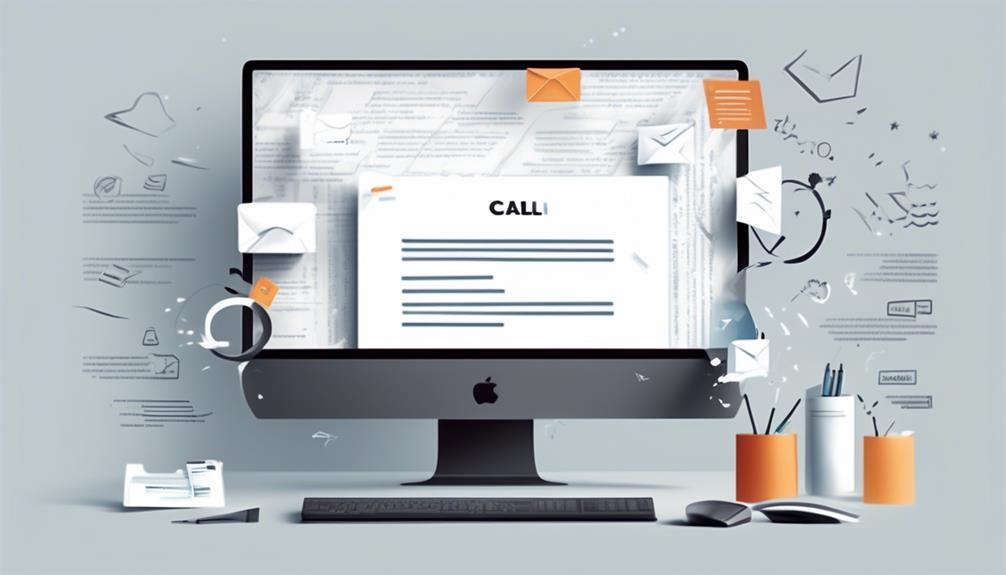As office employees, we have all experienced the frustration of sorting through a cluttered email inbox. Did you know that on average, a typical office worker receives 121 emails per day? With so much competition for our attention, it is crucial that our emails stand out for the right reasons.
There are several common pitfalls that can sabotage our communication efforts, and by avoiding these missteps, we can enhance the impact of our messages and cultivate stronger professional relationships.
But what are these mistakes, and how can we steer clear of them to ensure our emails hit the mark?
Key Takeaways
- Keep subject lines below 70 characters to ensure they are fully displayed in Gmail and on smartphones.
- Personalize subject lines to increase email opens and engagement.
- Address recipients by name to establish a meaningful connection and avoid using generic greetings.
- Focus on emphasizing the benefits of the product or service in the email rather than just listing features.
Lengthy Subject Lines
Let's steer clear of lengthy subject lines to ensure maximum email open rates. According to email etiquette, Gmail displays only up to 70 characters for subject lines, while smartphones show around 40 characters. Therefore, it's crucial to keep subject lines below 70 characters to optimize open rates.
Additionally, personalizing subject lines has been proven to increase email opens, while generic subject lines often lead to lost leads. This emphasizes the importance of tailoring subject lines to the specific recipients.
Furthermore, shorter subject lines are better for mobile users, so brevity and mobile optimization are key factors to consider when crafting subject lines. Avoiding spelling mistakes in subject lines is also crucial, as errors can detract from the professionalism of the email and may even cause it to be overlooked.
Generic Subject Lines

Crafting personalized subject lines instead of using generic ones can significantly improve email open rates and engagement. When it comes to professional email communication, the subject line is the first impression you make on the recipient. A generic subject line can easily get lost in a crowded inbox, leading to lower open rates and reduced engagement. To help you understand the impact of personalized subject lines, let's compare generic versus personalized subject lines in the table below:
| Generic Subject Line | Personalized Subject Line |
|---|---|
| "Important Announcement" | "Your Input Needed: Upcoming Changes to Project X" |
| "Monthly Newsletter" | "Exclusive Tips for Improving Productivity in Q3" |
| "Meeting Reminder" | "Action Required: Preparing for Quarterly Review Meeting" |
| "New Product Launch" | "Sneak Peek: Be the First to Explore Our Latest Product" |
As shown in the table, personalized subject lines provide specific information and a clear call to action, making them more compelling and likely to capture the recipient's attention. When crafting professional emails, it's essential to prioritize personalized subject lines to enhance open rates and engagement.
No Recipient Name
Addressing the recipient by name is essential in establishing a meaningful connection in email communication. When sending an email, it's crucial to make sure that you address the recipient by their name. Using a generic greeting like 'To whom it may concern' or 'Dear Sir/Madam' can make the email appear impersonal and decrease the likelihood of a response.
It's important to take the time to find out the recipient's name and use it in the email. If you're unsure about the recipient's name, consider reaching out to someone else in the organization to obtain the correct information. However, once you have the recipient's name, use it sparingly throughout the email to maintain a professional tone. Overusing the recipient's name can come across as insincere or overly familiar.
Focusing on Features Rather Than Benefits

When composing an email, it's essential to focus on the benefits of the product or service rather than simply listing its features. Emphasizing how the product can make a positive impact on the recipient is crucial.
People use products or services because of the value they provide, not just their technical specifications. Therefore, it's important to highlight the specific benefits that address the recipient's needs or pain points. By doing so, the email becomes more personalized and relevant.
When crafting the content, focus on the outcomes and advantages the recipient will gain from the product. This approach effectively communicates how the product or service will positively impact the recipient's situation.
Including a clear call to action that emphasizes the benefits further enhances the email's effectiveness. By focusing on benefits rather than features, the email becomes more persuasive and compelling, increasing the likelihood of a positive response.
Too Friendly
We should be mindful of maintaining a professional tone in our emails to avoid making recipients feel uneasy or cautious. While friendliness is usually appreciated, being overly friendly in an email can sometimes have the opposite effect. It's important to strike a balance and ensure that our tone is warm and approachable without crossing into overly casual or familiar territory. Here's a table to illustrate the potential pitfalls of being too friendly in emails:
| Too Friendly | Impact |
|---|---|
| Excessive use of emojis and exclamation marks | Can come across as unprofessional |
| Overly informal language and slang | May diminish credibility |
| Personal anecdotes and unrelated chit-chat | Could detract from the main message |
Frequently Asked Questions
How Not to Write an Email Example?
We avoid writing lengthy subject lines and use personalized and concise ones instead.
We address recipients by name for a connection and better response chances.
Our focus is on the benefits of the product or service, not just listing features.
We maintain a professional and polite tone, avoiding overly friendly or personal language.
Our call to action is clear, specific, and limited to avoid overwhelming the recipient.
What Are 10 Do's and Don'ts for Using Email?
We should personalize subject lines to boost email opens. Avoid vague subject lines and address recipients by name to increase responses. Generic greetings may seem spammy, so we should use them sparingly.
Highlighting product benefits, not just features, can engage recipients. Sending cold emails without personalization may yield no response.
These practices can enhance email effectiveness and engagement.
What Is a Poor Email Etiquette?
Poor email etiquette includes neglecting to personalize subject lines, using generic greetings in cold emails, focusing solely on product features rather than addressing recipient needs, and lacking a clear call to action.
These missteps can lead to low open rates, disengaged recipients, and limited responses.
It's essential to prioritize recipient-centric communication, maintain a professional yet friendly tone, and ensure a compelling call to action for effective email communication.
What Should You Not Say in an Email?
We should avoid using vague subject lines and filler statements, such as 'I hope you're well,' as they don't add value.
It's important to refrain from starting emails with unnecessary phrases like 'I am writing you because…' and to be cautious of using emojis and overly casual language.
When closing an email, it's best to avoid outdated sign-offs and ensure the closure is professional.
What are some common mistakes to avoid when crafting email pitches?
When writing effective email pitches, common mistakes to avoid include not personalizing the pitch to the recipient, writing long and wordy emails, not clearly stating the value proposition, and sending generic, mass emails. It’s important to tailor each email pitch to the individual recipient to increase the chances of success.
Conclusion
In conclusion, it's crucial to avoid common email mistakes in order to effectively communicate and maintain a professional image. By steering clear of lengthy subject lines, generic greetings, and focusing on features rather than benefits, we can ensure our emails are impactful.
Remember, it's better to be safe than sorry when it comes to email communication. As the saying goes, 'Don't cry over spilled milk.' Instead, be proactive and thoughtful in your email communication to avoid any potential misunderstandings or miscommunications.










